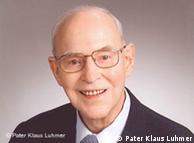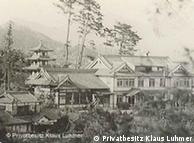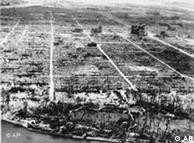World War II | 05.08.2010
Reliving the atomic bomb 65 years on
Father Klaus Luhmer was one of the lucky ones.
The Cologne-born missionary was four kilometers (two and a half miles) away from where the atomic bomb detonated over downtown Hiroshima on a red-hot morning in August 1945. With the temperature already rising past 30 degrees Celsius (86 degrees Fahrenheit) at not long after 8:00 a.m., he was praying in the garden of a residence for Jesuit novices on the outskirts of the southwestern Japanese city.
"Then there appeared, what I could absolutely not understand, harsher than the sun, a kind of hemisphere it seemed to me," Luhmer recalls.
"I had the instinctive notion that it was a normal high-explosive bomb that had exploded behind the nearest hill."
 Bildunterschrift: Großansicht des Bildes mit der Bildunterschrift: Luhmer had been living in Hiroshima for several years by 1945
Bildunterschrift: Großansicht des Bildes mit der Bildunterschrift: Luhmer had been living in Hiroshima for several years by 1945
He had enough time to rush down the steps to the cellar and take shelter. "I saw this bright flash, and a hot wave came over me. And I felt the shock wave. The house trembled and quaked, three-quarters of the roof tiles came down, like rain falling, and all the window panes shattered."
An American B-29 bomber had unleashed a nuclear weapon for the first time in history. Nicknamed "Little Boy," the atomic bomb wiped out two-thirds of Hiroshima's buildings, ultimately killing an estimated 140,000 people - over one-third of the city's population.
Black rain
Luhmer, though, needed to find out what had happened, and so climbed a hill behind the residence to look over the city. He saw Hiroshima ablaze.
"There were clear skies, but suddenly black clouds came and it began to rain. It was black rain. It was soaked by ash, which then came down with the rain as sediment," he recounts.
He returned to the Jesuit house, where the first casualties from the city were arriving. Luhmer saw many with skin hanging like rags from their bones, the fabric of their clothes partially molded to it by the heat. The Jesuits turned a dining table into a treatment table and began to care for those they could still help.
Luhmer and a small group of other priests set off for the city, meeting multitudes of injured people heading in the opposite direction. The center of Hiroshima offered an inconceivable picture to them. Fires were raging, houses and shops had collapsed, the dead and injured were lying between the ruins.
Luhmer recalls seeing several dozen soldiers, in full uniform, asking for ice or water to soothe their half-cremated bodies. "We were able to help them, as there was a well immediately nearby."
"But what can one do alone? Dozens, hundreds, of hands were needed to move the people in most urgent need."
Burning bodies
Luhmer and his colleagues did what they could, toiling in the ruins for two days. Then, the Japanese military sealed off the city, sending soldiers in to dispose of the vast numbers of dead bodies.
"They had the task of taking the corpses out of the wreckage and throwing them on a big pile, dousing it with petrol and setting it on fire," Luhmer says. "That is what is left of the people. They are considered to be missing."
 Bildunterschrift: Großansicht des Bildes mit der Bildunterschrift: Luhmer's Jesuit residence was far enough away from where the bomb detonated to survive
Bildunterschrift: Großansicht des Bildes mit der Bildunterschrift: Luhmer's Jesuit residence was far enough away from where the bomb detonated to survive
The priests returned to their residence on August 8, to find a similar task awaiting them. A girl to whom he'd been teaching piano came to him to say that her father had died.
Luhmer wished to spare the man's wife from an upsetting task. He sorted wood and straw into a funeral pyre and burnt the man's body. "That was a terrible stench that I will never forget as long as I live," he remembers.
The following day, the United States dropped a second atomic bomb on the city of Nagasaki, killing around 150,000 of the city's 240,000 residents. Japan announced its surrender on August 15, and the Second World War was over.
Despite having lived through the destruction of Hiroshima, Luhmer took strength from the endurance of humanity he witnessed.
"You become hardened against all these unspeakable things," he says.
His voice softens, and he sounds almost surprised at his own words. "After such a catastrophe, the people build things up again. That is the fascinating story of human life. It goes on. On and on."
Author: Silke Ballweg / tms
Editor: Michael Lawton










No comments:
Post a Comment